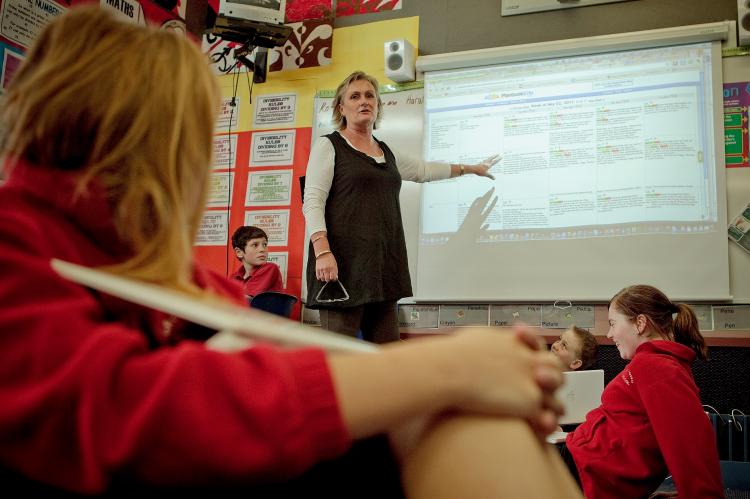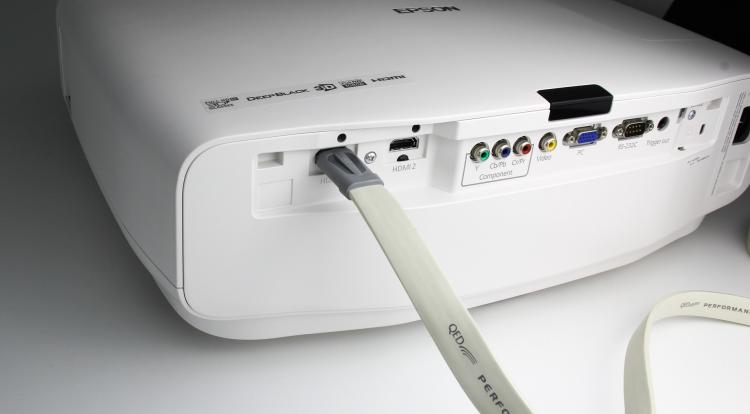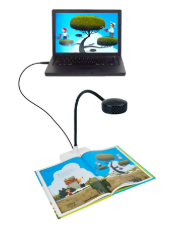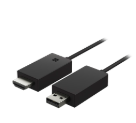Audio visual technologies
What are audio-visual technologies?
Audio visual (AV) is electronic media possessing both a sound and a visual component.
Audio visual technologies include:
- screens, for example, monitors, TVs or displays
- projectors
- interactive whiteboards and touchscreen technologies
- immersive technology such as virtual reality (VR), mixed reality (MR) or augmented reality (AR)
- audio systems
Purpose of AV technologies
Audio visual technologies provide ways for students to interact with and engage in learning and teaching activities. They enable students to be both creators and consumers of knowledge.
More information »
Choosing – TV or data projector
When it is time to add or renew the display technology in a classroom, the first choice is usually whether to install a TV (sometimes known as a display) or a data projector.
Size and position
The major factor to consider when choosing a projector or TV is the image size.
Unless the TV is very large, small details on a TV screen are not easy to see from the back of a classroom. Commonly, websites rely on small details so a TV may not be appropriate for a large classroom.
If the main purpose of the display is for small groups then a TV might be more suitable.
If the room is large then a projector may be preferable. Or, you could consider purchasing two TVs connected with an HDMI cable that both show the same image.
A good viewing experience requires you to also carefully consider glare, reflections, viewing angle, height, and the viewer's distance from the screen.
Decision making considerations
Additional considerations
- Unless a TV is being used for small group work or the projector/TV has particularly good built-in speakers, a separate audio system is also likely to be required.
- Wireless connectivity from the device to the projector or TV of some kind is preferable to having to cable in from a fixed location. This allows for greater mobility and sharing of what is on everybody’s screen rather than just what is on the teacher’s screen.
- Connecting the projector or TV to the school network and internet adds functionality but also complexity. Carefully consider if you would really use this functionality to justify the additional expense required.
- New, LED and laser bulb-free projectors are becoming available that don’t require bulb replacements but these are currently considerably more expensive.
Connecting devices to displays
Many teachers will already be familiar with using cables to connect with a TV, data projector or whiteboard but now there are many other options. The proliferation of mobile devices has led to a number of solutions to "play", "throw", "cast" or "mirror" screens.
Wired connections
Some devices connect directly to the TV or projector using a cable. They may need an adapter (sometimes called a dongle) to convert from one socket type to another. If there are a variety of devices in the room to be displayed then a variety of cables and adapters might be needed. Wired connections tend to be very reliable until the wires fray and pins become loose. The downsides of a wired connection are that they limit the connectivity to within only a few metres from the screen, the cables can be bulky and need to be taped to the floor to prevent hazards.
Document camera or visualiser
This is not a technically elegant solution but many teachers find it just as effective to put a mobile device under a document camera or visualiser to show what is on the screen. This projects the mobile device screen onto the big screen. The advantage here is that, as long as the camera is in place and is working, the set-up is nice and simple. The document camera can also display things that can't "cast" like a book, picture, or science experiment so it is a useful tool to have.
Specialist software
It is possible to connect a variety of mobile devices to a display via a "master" laptop or desktop computer running specialist software. For example, if your teacher laptop is always connected to the projector or TV, it can run software that the mobile devices connect to and display their screen on the TV or projector. Examples of software for this include AirServer , Annotate , Mirroring360 , and X-Mirage . The key advantage of these solutions is that the teacher is always in control of what is being shown on the screen. A downside is that the laptop is "tied up" when a mobile device is being used on the TV or projector. To overcome this, you could provide a computer that is permanently connected to the TV or projector to run this software so that it can display students’ mobile devices.
Other software solutions include:
Each of these has a more comprehensive feature set than only providing screen mirroring.
Specialist hardware
There are a number of specialist hardware solutions that are used to display a mobile device on a bigger screen. Common examples include the Apple TV, Chromecast, Miracast solutions (that support the Miracast protocol) such as the Microsoft Display Adapter and an increasing number of devices that support multiple platforms but which require an app to be installed on devices to work.
The mobile devices connect wirelessly to them and are able to "play", "throw", "cast" or "mirror" their screens. Some projectors or TVs may have in-built capability but, unless it uses the Miracast protocol, this can be limited to particular proprietary standards, such as Sony’s or Samsung’s systems that only work between their own brands of TVs and mobile devices.
In general:
- AppleTV – works best with Apple devices (like iPads and MacBooks)
- Chromecast devices – work with Chromebooks, Windows, or Apple laptops that run the Chrome Browser or mobile phones and tablets such as iPads running Chromecast-compatible apps
- Miracast devices – work with devices running Microsoft Windows along with some Android phones and tablets but they do not work with Apple’s devices
- multi-platform devices – tend to be more expensive than individual devices and will require an app to be installed but you may only need to purchase one of them.
Advice when considering your solution
- Test and trial – always get hands-on with the proposed technology solution in real-life situations.
- Find out the experience of others – request feedback from other schools using your Personal Learning Network, Twitter, Facebook, and so on.
- Liaise with your technical providers – ensure they understand what you’d like to achieve and ensure you know what the technical limitations or things to overcome might be.
Logistics
Consider:
- how you will store and power the device
- what parts can go missing
- how you can keep it secure
- who has control of the settings – requiring a passcode to connect to the displaying device can prevent students from changing another room’s display
- how to get audio working – sound is equally important to the display aspect of screen mirroring
- what support will be required – teachers may need some help to get started and to know where to go for help when they need it.
Wi-Fi and other technical configurations
- Consider extra technical information, for example, AirPlay requires specific ports to be open on the network for the special Bonjour protocol that AppleTV uses (and frequently they are not configured to be open).
- Mobile devices and the display devices often need to be on the same network (subnet). This might mean that they will all need to connect to the same Wi-Fi SSID.
Compatibility and connectivity
- Check compatibility with different mobile device types to ensure the solution meets your needs.
- Check compatibility with your projector, for example, very old projectors only have VGA or DVI connections so a VGA or DVI to HDMI converter may be required.
- Check connectivity to the network. Cabling in a display (hardware) device to a wired ethernet port to connect it to the network is likely to provide a better result than connecting it via Wi-Fi.
Performance and features
- The system must be reliable and easy to use if it is to be used by anyone.
- Some systems allow multiple mobile screens to be displayed which could be useful.
- Some systems enable recording the session and saving it as a movie file.
- Education-specific functionality and suitability might be important, for example, adverts should be removed.
Costs to consider
- Device and/or software costs.
- Set-up costs – some solutions can be centrally configured and managed, for example, Apple TVs can be managed with Apple’s Configurator software or third-party Mobile Device Management solutions.
- On-going time – for example, time may be needed to keep the configurations up-to-date because, typically, an update to the operating system of the mobile device can require a subsequent update of the display device’s software or firmware.
- Version upgrades of the particular software used may require additional costs.
- Factor in the costs of having a backup system for connectivity such as cables and dongles.



